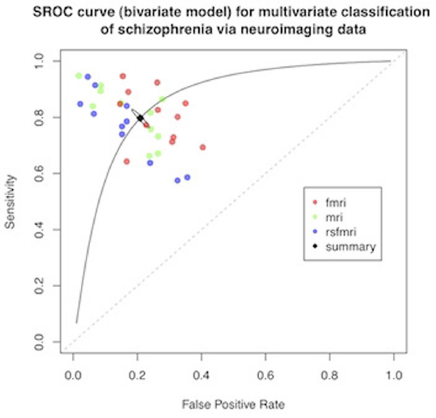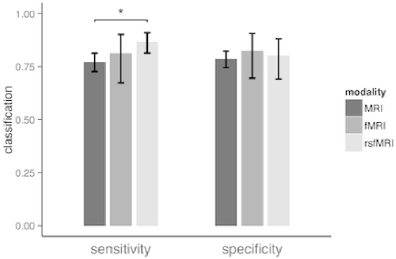No CrossRef data available.
Article contents
EPA-1671 – Diagnosing Schizophrenia Using Neuroimaging: A Meta-analysis of Multivariate Pattern Recognition Studies
Published online by Cambridge University Press: 15 April 2020
Abstract
Numerous studies have applied novel multivariate statistical approaches to the analysis of brain alterations in patients with schizophrenia. However the diagnostic accuracy of the reported predictive models differs largely, making it difficult to evaluate the overall potential of these studies to inform clinical diagnosis.
We conducted a comprehensive literature search to identify all studies reporting performance of neuroimaging-based multivariate predictive models for the differentiation of patients with schizophrenia from healthy control subjects. The robustness of the results as well as the effect of potentially confounding continous variables (e.g. age, gender ratio, year of publication) was investigated.
The final sample consisted of n=37 studies studies including n=1491 patients with schizophrenia and n=1488 healthy controls. Metaanalysis of the complete sample showed a sensitivity of 80.7% (95%-CI: 77.0 to 83.9%) and a specificity of 80.2% (95%-CI: 83.3 to 76.7%). Separate analysis for the different imaging modalities showed similar diagnostic accuracy for the structural MRI studies (sensitivity 77.3%, specificity 78.7%), the fMRI studies (sensitivity 81.4%, specificity 82.4%) and resting-state fMRI studies (sensitivity 86.9%, specificity 80.3%). Moderator analysis showed significant effects of age of patients on sensitivity (p=0.021) and of positive-tonegative symptom ratio on specificity (p=0.028) indicating better diagnostic accuracy in older patients and patients with positive symptoms.


Our analysis indicate an overall sensitivity and overall specificity of around 80 % of neuroimaging-based predictive models for differentiating schizophrenic patients from healthy controls. The results underline the potential applicability of neuroimaging-based predictive models for the diagnosis of schizophrenia.
- Type
- E01 - e-Poster Oral Session 01: Schizophrenia
- Information
- European Psychiatry , Volume 29 , Issue S1: Abstracts of the 22nd European Congress of Psychiatry , 2014 , pp. 1 - 2
- Copyright
- Copyright © European Psychiatric Association 2014





Comments
No Comments have been published for this article.